I’ve been thinking a lot about the whole, “Less Meat, Better Meat” position lately. I get where it comes from, but I worry that it might be creating the wrong message. To me, I feel that this implies that we’re eating too much meat, and that meat is “bad.” As a nutritionist living on an organic farm, raising pasture-based animals, I worry that people under-eat protein, overly-vilify meat, and eat way too much sugar, vegetable oils and grains.
[Tweet “We need less food, better food while getting more protein, better protein”]
We’re Not Eating Enough Protein
I decided to look into this issue deeper, and what started as a short post has grown into several sections. In my first post, I explored how much meat we’re supposed to be eating. I discovered that the RDA for protein is the minimum amount to prevent disease. The alternative, “Acceptable Macronutrient Distribution Range” (AMDR) has a very wide recommendation range of 10% – 35% of calories from protein. In fact, it says here that the low end of the AMDR is set at the RDA. Many sources are telling us that we only need about 45g – 55g of protein for men and women, which is much lower than the AMDR, and is based on 0.8g/kg of “reference” people who do not represent average Americans. I also found that overconsumption of protein poses no danger, and can actually lead to reduced overall caloric intake (see this post for more information.)
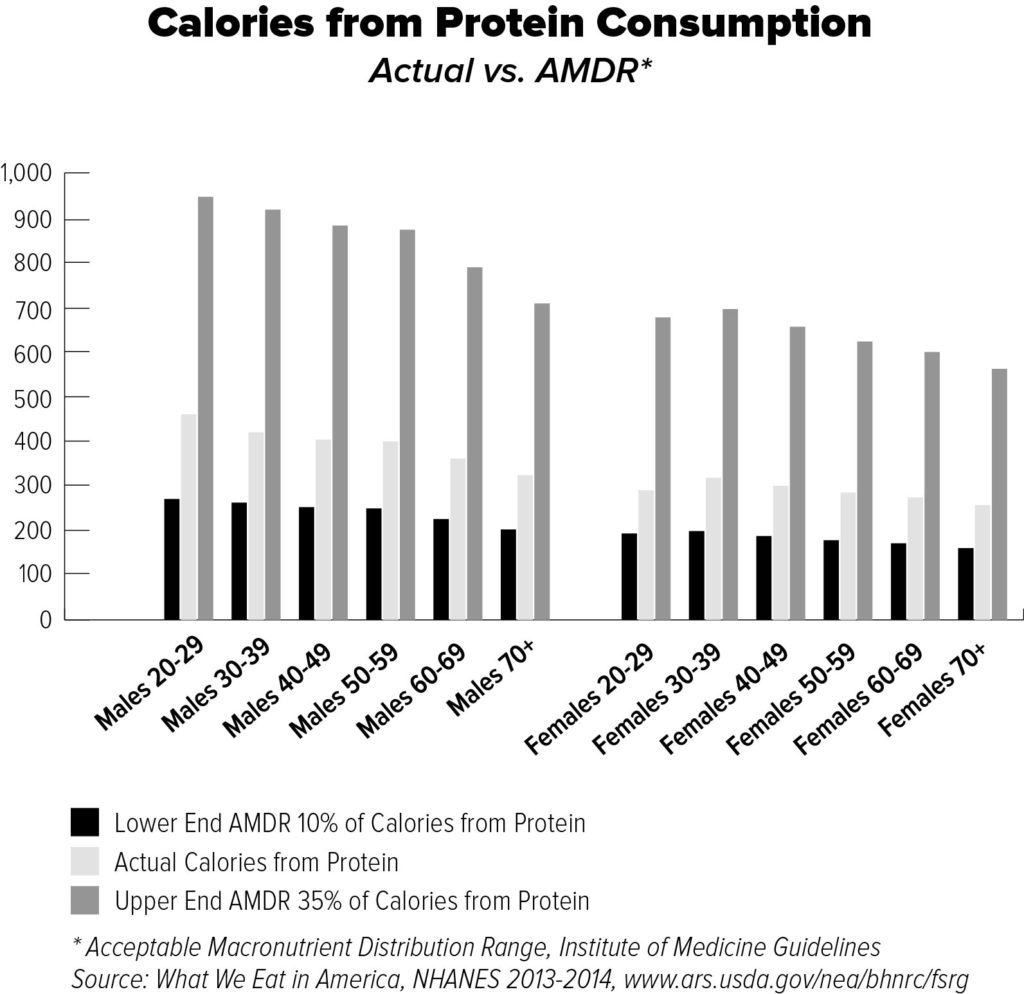
Then, I looked into how much protein and meat we’re actually eating. Not that much. On average, we’re only taking in about 15%-16% of our calories from protein, which is also at the low end of the ADMR. As far as meat intake goes, it looks like we’re only eating between 5 and 6 ounces of meat a day, not the nearly one pound a day that many cite. This is hardly what I would consider “too much.”
Now let’s look at which sources of protein are optimal, from a nutrition perspective…
The Protein Digestibility Score
When looking for the most optimal forms of protein, the protein digestibility corrected amino acid score (PDCAAS) has been adopted as the preferred method for measuring how proteins best meet human nutrition needs. Table 1 shows beef, eggs, milk and soy proteins as the highest in nutritional value. However the PDCAAS score does not account for “antinutritional factors” like trypsin inhibitors, lectins and tannins which can reduce protein hydrolysis and amino acid absorption from plant-based proteins like soy. Digestibility of plant proteins are also affected by age and the state of the gut. It is widely agreed then, that meat is the most bioavailable source of protein (eggs, milk, meat, fish and poultry.) Meat-based proteins also have no limiting amino acids, where soy is missing methionine and is not considered a “complete” protein.
Context Matters: Twisted and Wrong Data
Not only is meat the most bioavailable source of protein and B12 and iron, but by serving size, calorie for calorie, and by volume, it’s also incredibly efficient at delivering nutrition in an easily digestible form. Since most of us are not looking to increase our overall caloric intake, getting more protein from meat vs. plant based proteins might be smart. For example, you would need to eat nearly 3 1/2 cups of broccoli in order to get the same amount of protein in just 2 ounces of beef.
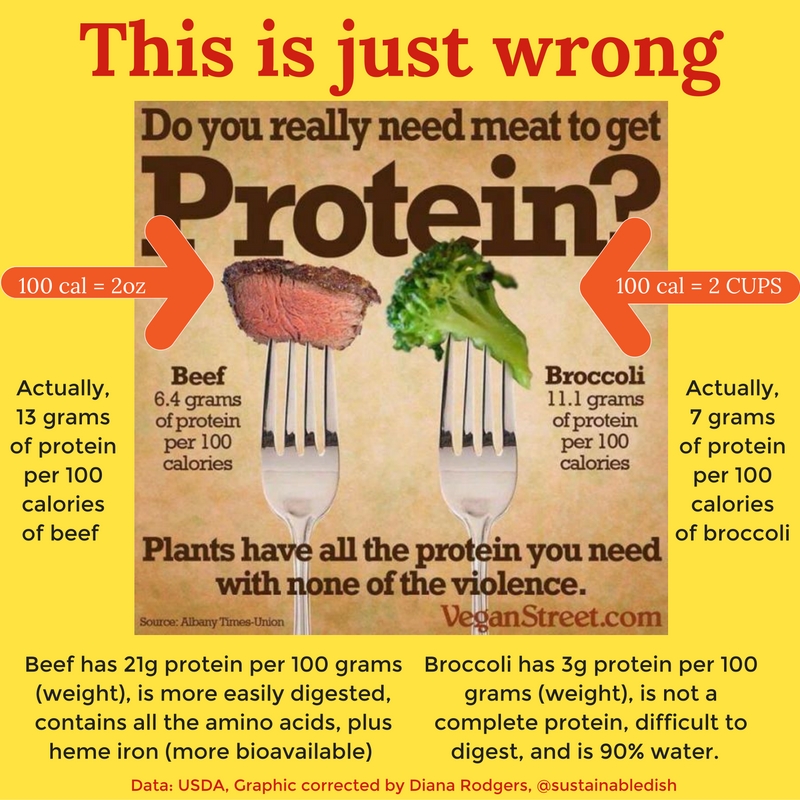
Comparing Plant-Based Protein to Animal Protein
If you google “plant based protein images,” there are lots of charts showing how easy it is to get your protein from things like beans, broccoli and tofu. Below is an example…
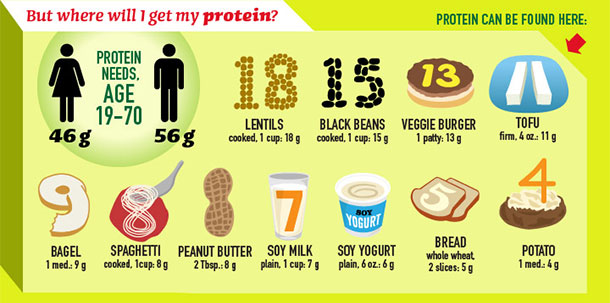
First of all, I’d like to point out that the 46g and 56g of protein needed for women and men is incorrect. In this post, I illustrate that these values are based on a “reference” woman of 125 pounds and a man of 154 pounds getting 0.8g of protein per kg of bodyweight. The “reference” people DO NOT represent the average weights (which are about 166lbs and 195lbs, respectively) and the 0.8g/kg is based on the minimum amount of protein required to avoid disease – not the amount required for optimal health.
[Tweet “The RDA for protein (0.8g/kg) is the minimum, not the optimal amount”]
In my practice, I recommend eliminating sugars and processed foods, and will usually start women on at least 100g of protein per day and see how it goes from there. More for men. That being said, let’s look at the above plant-based protein sources and see what the protein is per serving with plant-based vs. animal-based proteins:
In the above chart, I took all of the foods listed in the vegan “ideal” protein chart, and compared them to animal-based proteins. If you look at the typical suggested servings of these foods, you can see that the chicken, beef, pork, and fish are significantly more protein-dense per serving than any of these relatively high protein sources for those on a plant-based diet.
Now, let’s look at how much you’d have to eat of these plant-based sources in order to get the same amount of protein from meat. I calculated out how many calories you’d need of each of these items in order to get 30g of protein.
As you can see, meat and seafood are much more efficient ways to get your protein compared to plant-based sources. And, since most of us are not looking to increase our caloric consumption, yet should be getting more protein, then nutritionally speaking, animal sources (specifically from flesh) are the most desirable sources.
In order to get the same protein in a piece of fish or chicken, you would need to consume 706 calories of peanut butter! You’d need 3.5 cups of spaghetti (nearly 800 calories) to get 30 grams of protein, and you’d have to eat 10 potatoes (1635 calories). Yikes!
[Tweet “To get 30g of protein you can eat one piece of fish or 10 potatoes”]
Of all of the plant based choices represented on the chart, I’d consider lentils to be the most desirable – as they’re the least processed, non-soy option. You’d have to eat 1.5 cups of lentils, which is 337 calories, in order to get the same amount of protein that you can get from 3.5oz of fish, at about 1/3 the calories. Add this up over the day and you’ll see that getting all of your protein from non-meat sources is incredibly expensive, calorically speaking. If you’re happy with your health, weight and metabolism on a plant-based diet, then fantastic. If you’re not, then please consider pulling in some animal protein to help cut down on calories and help you feel satiated.
What Vegetables Are Missing
It can’t be overlooked that animal protein has several additional benefits other than just being an efficient source of protein. Red meat is the best source of heme iron, which is the number one nutrient deficiency in the world. Compared to white meat, it is also richer in B12 and zinc. That said, chicken is more nutrient-dense than plant-based protein.
But Meat is Bad for the Environment!
Because I already dove into the full effects of red meat (carbon, methane and water) in this post, plus calculated the amount of feed needed to produce beef here, I’ll just sum it up by saying that red meat is a much better protein choice than plant-based proteins. This is because it actually doesn’t take the amount of water or feed that people mistakenly report (because of poor methodology), and it doesn’t cause the environmental destruction that many people assume. 100% pasture-raised animals like grass-fed beef, lamb and goat are optimal, as the pastureland they graze doesn’t compete with humans for vegetable production. Less desirable are animals that consume grain as their only input, like Confined Animal Feeding Operation (CAFO) pigs and chickens. You also might be surprised to learn that “typical” cattle are not eating grain their entire lives. When I calculated the amount of grain a typical cow eats per pound of flesh, the number was much closer to the Feed Conversion Ratio (FCR) of chicken. Think about how many more people one cow can feed vs. one chicken!
Eat Less Grains and Less Animals that Eat Grains
Mono-cropped grains used to feed CAFO animals and used to produce soy-based meat substitutes, bread, bagels and spaghetti destroy biodiversity by eliminating habitat in order to clear fields for production. The spraying of chemicals for fertilizer and herbicides has a tremendous carbon footprint, not to mention all of the energy and water required to process these items from their whole forms into the foods most commonly eaten. I’m pretty certain that if a full life cycle assessment (the complete inputs of water, energy, etc.) of a product like a veggie burger was compared to the same amount of protein that can be produced by a grass-fed cow, it would certainly reveal that the grass-fed cow is the better choice from an energy and environmental standpoint.
[Tweet “Eat less grains and less animals that eat grains for a more sustainable diet”]
But it’s Not Right to Eat Animals…
Morally speaking, I know it seems “cleaner” to eat a plant-based diet, but as I describe in this post, it’s actually impossible to be a vegan, because there is no such thing as a bloodless diet. All life requires death. I also dive into this topic more in this post, where I explain the principle of least harm, and illustrate that many animals actually die in order to produce a product like tofu.
In addition to the animals that are dying during the tilling and harvesting of your crops, there are also many animals harmed in the production of many vegetarian products. Palm oil is a great example. I’m not sure that palm oil should really be considered “ok” on a vegan diet when you consider the impact this industry has on orangutans. What about the humans that are harvesting your vegetables? I see very little attention given by those in the plant-based world to human social justice issues. What about the 400,000 children that are migrant farm workers?
Biologically speaking, humans are omnivores, and our digestive systems are made to eat a mixture of foods from plant and animal sources. Since blood is spilled even for a plant based diet, doesn’t it make sense to eat the animals? Additionally, thinking that a “natural death” is somehow equal to “painless death” is absolutely naive. Have you ever seen what a coyote or hyena can do? All things don’t die peacefully in their sleep. Humans actually have the unique ability to consider being “humane” when ending a life. This is something hyenas do not do.
This past summer, I asked Joel Salatin what he says to the many plant-based folks that give him a hard time. His reply, “All life comes from death. If you don’t believe, go lay down naked in a flower patch for three days.”
Is Chicken a “Cleaner” Meat?
Our production of chicken has risen nearly 400% over the last 50 years, while beef production has remained the same. Are we really saving the world by eating more chicken? Are we much healthier? Is chicken a “cleaner” meat than red meat? CAFO chicken and pork are not only produced entirely on grain, but spend their whole lives indoors, under fluorescent lights, and are barely able to move around. Even feed-lot beef has it better, because contrary to what people assume, these cattle spend the majority of their lives on grass. Even when they are transported to a feed lot, they can move freely and are not indoors. Compared to CAFO chicken and pork, feed-lot beef is a much better choice from an animal welfare standpoint.
[Tweet “Is “cage free” chicken really better than red meat? “]
What do you think is a “cleaner” meat?
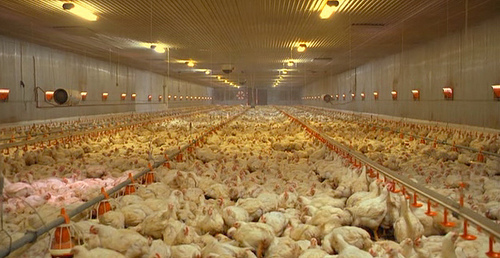
vs.
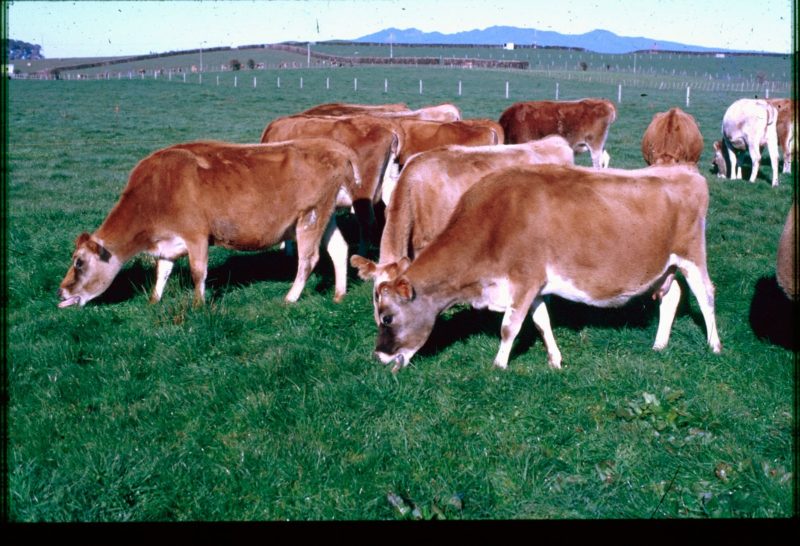
A Chicken In Every Pot
Chicken production is up 400% over the last 50 years, while beef production is up 0%. The way we raise CAFO chickens is disgusting. They are so overly domesticated – bred for large breasts, that by about 5 weeks, they are hardly able to walk and will die of organ failure if you don’t process them first. Antibiotic use is rampant in the chicken industry, because of their toxic living conditions. “Cage free” CAFO chickens are not really a better solution. Chickens are highly stressed in CAFO situations and will cannibalize each other, which is why their beaks are trimmed and they are separated from one another. The use of cheap grain, cheap oil, and widespread antibiotic has allowed chicken to be the least expensive meat in the U.S. at $1.50 per pound (the average price of chicken as of Sept 2016).
The term, “A chicken In every pot” was first stated by Henry IV of France: “I want there to be no peasant in my realm so poor that he will not have a chicken in his pot every Sunday.” This is because chicken was such a luxury. During the 1928 Hoover campaign for presidency, the term was brought back, “A chicken in every pot and a car in every garage,” as a promise of prosperity to voters.
Chicken vs. Beef
Today, chicken also represents a “clean” meat. Cookbooks espousing “clean” eating, often will avoid red meat but include fish and chicken. Boneless, skinless chicken breast is free of “bad” fat, sold in “manageable” portions, and doesn’t have “blood” – the red liquid in beef packages that is not really blood but rather myoglobin released by muscle tissue after processing. We like chicken because it’s white meat, and when it’s off the bone, it doesn’t remind us of its animal origins. It’s sort of like the animal equivalent of tofu. Also, think of how many chickens are needed to provide meat for a person, compared to the number of cows. One cow produces an average of 490 pounds of edible beef, and the grain it takes to produce a pound of edible beef is actually equal to chicken. If you were to purchase one cow (490lbs) for your freezer and eat it over the course of a year, that would give you 1.3 pounds of meat per day. When you’re looking to cause “least harm,” one cow is a much more efficient life to lose than the number of chickens it would take to equal 490lbs.
I think we also don’t like the idea of eating cows because they more closely remind us of our pets than chickens do, with their big eyes and cute faces. Chickens (and fish, which are also considered “clean” animal protein) are just not as cute as cows, goats and sheep.
Context Matters: A Guide to Optimal Protein Sources
Truly pasture-raised chicken is quite difficult to source compared to the growing market for grass-fed beef, and if you are interested in causing the “least harm,” one cow provides much more meat than one chicken. Plus, grass-fed red meat is much better for the environment than chicken. This is why I advocate eating much less chicken and much more grass-fed red meat. However, if you’re close to a producer of pasture-raised chickens, then by all means, buy some. The same goes for fish: if you live near a source of fantastic fish, then that should make up a much larger part of your diet than someone who lives in Kansas.
I thought it might be helpful to come up with a general rating system for those who are looking for healthy meat that also are concerned about their environmental “footprint.” This is not a firm science – for example, some grass-fed beef is produced by ranchers who practice Holistic Management (the gold standard), while other grass-fed cattle are on the same, overgrazed patch of grass every day of their lives. The nutritional quality of the protein should also be considered. So, when looking at the below chart, please keep in mind things like production methods, geographic location, dietary preferences and availability.
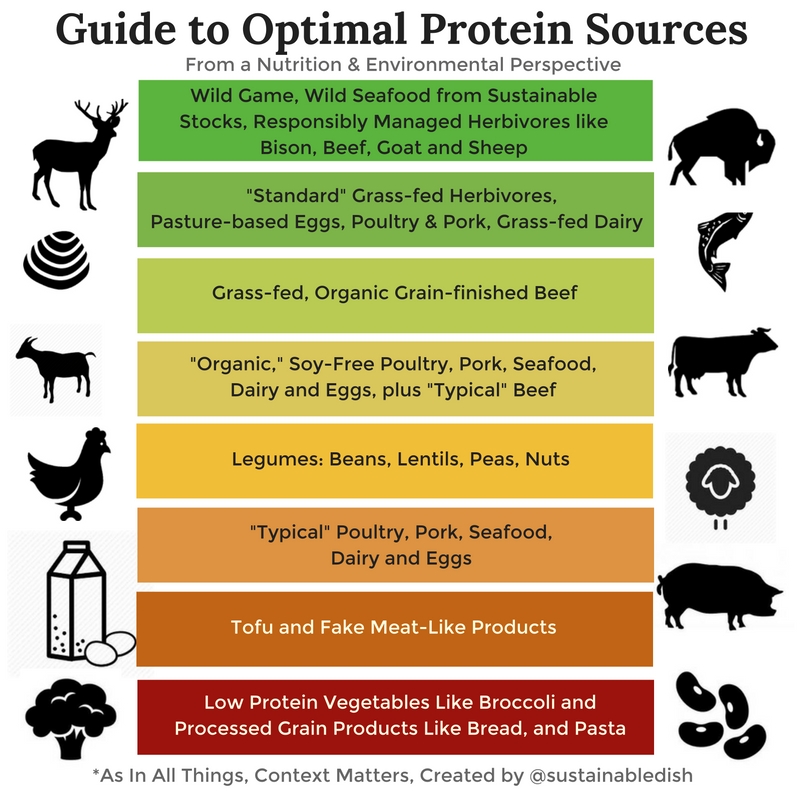
I should also note that this chart is taking into account the cultural preferences of America. I have some friends in the Andes who love cuy, which is incredibly sustainable (requiring little space and food) and is considered a delicacy there, but I don’t see that catching on here.
You might notice that I put “typical” beef above “organic” poultry. This is because the term “organic” doesn’t really mean much these days, and I feel that even “typical” beef that has been finished on grain is superior to chicken because at least these cows spend their lives outdoors, have eaten mostly grass, and are not confined inside, under florescent lights (I explain more here). The current organic standards for poultry only require that the birds have “access to” the outdoors. This could mean a couple of small doors that the birds may not even see. I also placed legumes above tofu because they fix nitrogen (improving the soil), and are more easily digested than soy. For those on a vegetarian diet, I recommend concentrating on legumes for protein instead of soy or highly-processed fake meat products.
Meat is Expensive
I’m cutting you off at the pass, because I know what you’re going to say next. Yes, good meat is expensive. But it’s actually not as expensive as you might think. If you compare nutrient-dense meat like organic, grass-fed beef to a common junk food item like a snickers bar, you might be surprised to learn that the organic, grass-fed beef is $0.17 cheaper by weight than a snickers bar. (Check out more charts here on why you do actually have the money and time to eat well – including how we’re spending less on groceries yet have a higher standard of living than ever before – AND we’re buying less meat and more processed food!)
What Does 10% – 35% of Protein Look Like?
As I mentioned earlier in this post, the ADMR for protein is 10% to 35% of calories. I have experimented a lot with my diet, and have found that a higher protein, lower carb diet seems to work best for my body. Here is a typical day:
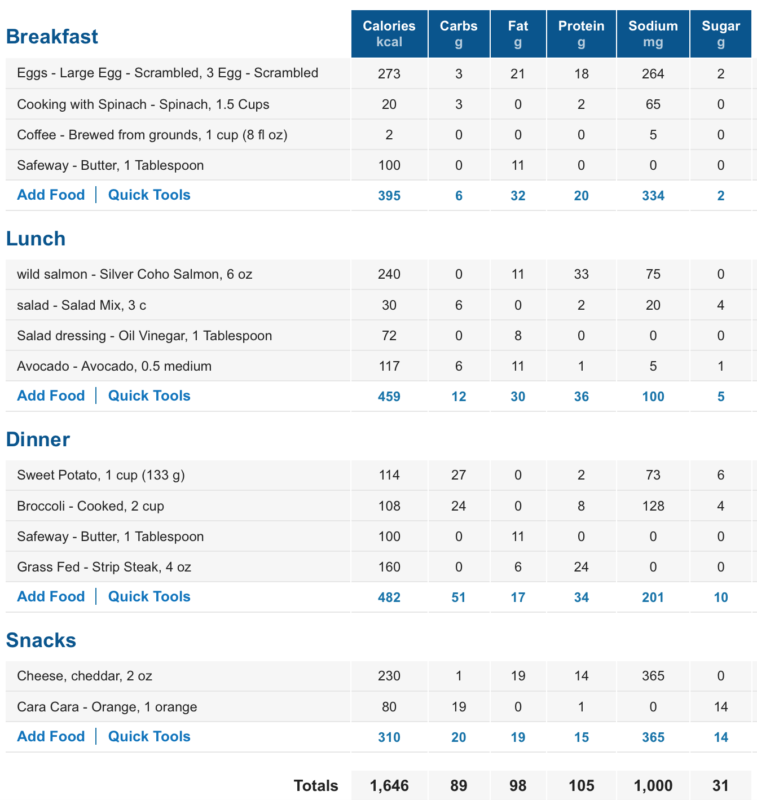
In order to get about 25% of my calories from protein (105 grams), I needed 3 eggs, 6oz salmon, 2oz cheese and a 4oz steak. That’s a lot more animal protein than what is currently recommended by the US Dietary Guidelines, and much more than most Americans are eating. To get that much protein from plant-based sources, the total caloric intake would go way up. If you eat more calories than I do, then I recommend that you also increase your protein.
I also wanted to point out that I do advocate eating vegetables. In fact, I eat a lot more vegetables now than ever before. Just because someone cuts out most grains, sugars and increase protein does not mean that we are ignoring fresh vegetables. When folks come to me and say they don’t eat meat because they don’t believe in factory farming, I see it as the same as someone saying they don’t eat vegetables because they don’t believe in GMOs. There are alternatives, folks!
So in closing, I dislike the phrase “Less Meat, Better Meat,” because I feel that it implies that meat is “bad,” or that we’re eating too much of it. I think the idea, “meat is a condiment,” shames meat, and ignores the fact that meat is the most satiating macronutrient, is incredibly nutrient-dense, and when properly raised, can actually benefit the environment. The only way we are going to have better meat is to create a demand for it.
If we look at the science, humans need more protein – and as I’ve argued here in this post, meat is a superior protein to plant-based, both from a nutritional and environmental perspective. At the same time, we need to dramatically reduce our intake of sugars, vegetable oils, and grains. By sticking to “natural” foods, which our bodies have been designed to thrive on, like pasture-based meats, sustainable seafood, healthy fats, organic vegetables and fruit, I believe we can all live a much healthier life, and save the planet as well. I think there needs to be a new dialogue, “Less Food, Better Food,” (less grain, less vegetable oils and less sugar) and“More Protein, Better Protein.”
Looking to source better meat?
Honest Bison offers grass-fed bison meat – and my link gets you a free pound of ground bison with your order, use code sustainabledish
Connect with a local pasture-based meat farmer by going to eatwild.com
I’m have a bias of course, but check out Clark Organic Farm if you’re in the Boston area for amazing pasture-raised pork (40lb boxed shares available now).
I also love US Wellness Meats, Vital Choice Seafood, and Maple Hill Creamery (100% grass-fed, full fat dairy)
For more on the topic, check out:
How Much Protein Do We Really Need?
How Much Protein/Meat Are We Actually Eating?
Meat is Magnificent: Water, Carbon, Methane and Nutrition
Why is it Necessary to Eat Animals?
It’s Impossible to be Vegan: Lessons from a 10yr Old Girl
How Much Feed Does it Take to Produce a Pound of Beef?
Need help incorporating more meat into your diet? Learn how to work with me.
Read:
The Paleo Solution by Robb Wolf
Defending Beef by Nicolette Niman
Cows Save the Planet by Judith Schwartz
The Soil will Save Us by Kristin Ohlson
Carbon Soil Restoration: Can Biology Do the Job? by Jack Kittredge (a white paper from NOFA)
Watch:
The Story Of Meat from Savory Institute on Vimeo.









48 thoughts on “More Protein, Better Protein”
I love this, Diana! It frustrates me to see those infographics that say beans and grains have enough protein and we don’t need meat. And I agree that most people aren’t getting enough protein in their diet. I’ve recently been assessing, and realized this is true for myself and my husband, too. So, I’ve been trying to keep more meat prepped and ready.
I appreciate that you did research and covered this topic pretty thoroughly. 🙂 Thanks for putting this all together!
Thanks!
Very well stated and thought out. You’ve must have heard about every vegan argument there is.
I’m sure more are on the way!!!
I think you may have a mistake in your excellent article. Did you mean 0.8g/kg for rda protein requirement? You’ve listed 0.8g/lb protein which is a greater amount than 46g and 56g for women and men.
Thank you for catching that! I will update it.
Fantastic article, Diana! I completely agree with you in that most of us do not consume enough protein at each meal (which leaves us hungry and snacking on quick carbs/sugars between meals) and red meat, in general, isn’t appreciated for the macro and micronutrients it provides (not to mention how bioavailable those nutrients are!) “Less Food, Better Food” I love it! It would benefit us all tremendously if we cared more about the quality of our food. As a society, we are overweight and undernourished and we’re blaming literally the most nutrient-dense category of food (red meat) for our health concerns, it’s ridiculous! Thank you for sharing your perspective in this blog post!
I’m so glad you liked it Christie!
Excellent post, as always! I’m curious as to why many reputable, purportedly balanced writers on food and sustainability make the claim that world consumption of meat is far too high and can’t be sustained as more cultures adopt a Western-style diet. I eat an amount of protein very similar to what you described in your daily diet. Everyone I know is comfortably middle-class and eats a standard Western diet and yet they eat less meat, cheese and eggs than I do. If the claims these writers make are correct, there are a lot of people out there eating 2-3 lbs of protein a day, which I don’t think is physically possible!
Is it true that eating meat is hard on my body if I don’t have a gall bladder?
I take ox bile and an HCL + pepsin supplement–if I have the correct dosages of those, am I ok eating animal protein at each meal?
A gallbladder stores bile, which is required to break down fat. Protein digestion occurs in the stomach, and is broken down with acid, not bile. There are supplements you can take that make it easier to digest fat. I help people with this sort of thing in my nutrition practice – let me know if you’d like to book a consult!
Pingback: [BLOCKED BY STBV] 10 Reasons to Stop Eating So Much Chicken - Sustainable Dish
Pingback: [BLOCKED BY STBV] Episode 60: Transitioning from Vegetarian to Paleo | Phoenix Helix
Pingback: [BLOCKED BY STBV] In Defense of Real Food: a Paleo & Whole30 Dietitian Responds to US News & World Report's "Best Diets of 2017" - Sustainable Dish
From the waterfootprint.org article you referenced:
In order to reduce the pressure on the world’s water resource associated with their consumption pattern,
individuals have the option of shifting from a meat-rich to a vegetarian diet. The water footprint of an individual
consumer depends to a large extent on the type of diet of the individual. Meat-based diets have a larger water
footprint compared to a vegetarian diet. The average USA citizen consumes almost four times the amount of
protein compared to the global average (FAO, 2009). About 63% of the daily protein intake comes from animal
based products. This high level of consumption of animal-based products is directly reflected in the relative large
water footprint of the average American citizen (Hoekstra and Chapagain, 2007). Replacing 50% of all animal
products by an equivalent amount of high nutritious crop products such as pulses, groundnuts and potatoes will
result a 30% reduction of the food-related water footprint. A vegetarian diet compared with the average current
per capita food intake in the USA can reduce the water footprint of an individual by as much as 58%.
All in context. That Hoekstra paper you cite is not just looking at blue water, but also green water (RAIN, etc). There are different ways of animal production that are much more efficient than others, as I mention in the article. Grass-fed meat grown on pasture is completely different than chicken that consumed all grain. The same goes for plants. Tofurky made from GMO soy and heavily sprayed mono-cropped wheat (incredibly wasteful process to make an expensive, poor product) is very different eating locally produced legumes, pasture-based eggs, raw milk cheese from grass-fed cows, and leafy green vegetables. I know people want black and white, yes and no answers to things, but as I mention, there is nuance and context and grey areas to any thoughtful argument. I have no problem with people choosing to eat a vegetarian diet if they want to, but it is NOT necessarily the most environmental, nor healthiest. I eat grass-fed meats, pasture-raised eggs, organic veggies. This, compared to a person living in a city eating CAFO eggs and dairy, lots of GMO grains and processed foods? There are good and bad ways to do everything, including trying to sway someone. I see that you’ve now commented on several of my posts without really reading them thoroughly. If you’d like to have an intelligent discussion, please consider reading what I’ve written. Also, please consider going to another site that doesn’t even consider animal welfare, social justice, or sustainability when choosing ingredients (like, practically ANY other food blog) and stop trolling my site. Have a great day Nicole.
Why are you doubling the amount of recommended protein and yet I read this data in original source research that you cite: The average USA citizen consumes almost four times the amount of protein compared to the global average (FAO, 2009)
Just because our meat intake is larger than the global average doesn’t mean it’s optimal. There’s a difference between surviving and thriving. The recommended protein range is 10% – 35% of calories from protein. A 2,000 calorie diet at 20% is 100g of protein. Even at 10% on 2,000 (the absolute minimum) would be 50g per day, which is HIGHER than what many people interpret as the optimal. If we’re looking to lower obesity and diabetes, I do not recommend that we go for the minimum intake of protein – a macronutrient that is filling, nutrient-dense, and calorically efficient.
I could not disagree with everything you say more. You are absolutely harming others and our planet. Today, there is absolutely no need for us to rely on animals for protein. Regardless of how humanely these animals are raised, there is no humanity in killing. There are significant benefits to a Whole-Foods Plant-Based diet which does not cause a detrimental effect on our planet like a diet based on animal-protein, We are the cause of global warming and climate change! By adopting a Whole Food Plant Based diet, individuals can save their own life. You can absolutely get everything you need from plants. We can reverse chronic diseases such as cardiovascular disease and diabetes. We can prevent cancer and disease progression! Please check out Dr. Campbell’s book The China Study. This is all evidence based medicine!!!
I’m familiar with the China Study and unfortunately, correlations are not proof of cause. Humans have been eating meat for our entire existence, so I really find it difficult to single out meat as the cause of modern disease, since what has really changed is our intake of processed foods, sugars and inflammatory seed oils are what we’re eating more of than ever. Plant-based proteins are nutritionally inferior to animal-based proteins, this is a fact even stated by the Academy of Nutrition and Dietetics. Modern agricultural methods like mono cropping of corn, wheat and soy are incredibly detrimental to the environment, where cattle can graze areas where we are unable to produce food (nearly 70% of the planet). We simply can’t crop everywhere due to topography, rain, poor soil etc.
Absolutely right Lisa!
I cured my cancer and heart disease by eating meat, dairy and eggs….said no one ever!
What do you think our ancestors would have said to this? The healthy humans that brought us to where we are today, eating meat, dairy and eggs? Are you positive that MEAT is the culprit, or could it possibly be something else new to the human diet, such as processed foods and environmental toxins like glyphosate? This is a serious question.
Diana is delusional and i’m sure has some stock options in the meat industry. First of all, our ancestors did not consume the amount of meat that we consume today. Secondly, our ancestors lived in different times. It may have been necessary to eat meat to SURVIVE back in the day! In this day and age, we have plenty of options that are CRUELTY FREE! Thirdly, look around you. Nearly everyone is FAT in our modern western society. Coincidence? I think not. 73.4% of Americans are overweight. Compared to 30% for the rest of the world. So stop with the BS and misguided information. We can survive AND thrive on a plant based diet. Just look up the plenty of world class athletes that are vegan. Lastly, there are millions of vegans alive and well today and not protein deficient.
stock options in “meat industry” ha? I assure you I’m not the only health professional that advocates for eating meat.
Your first point: What is your evidence of meat consumption across the span of human history?
Your second point: Not all plants are cruelty free – in fact, please show me a method of food production that requires NO DEATH. It’s impossible.
Your third point: yes people are sick and overweight, but what is the main difference? Processed food, not meat. Plenty of populations eat meat and are not overweight. You’re not presenting science here, just your personal observations.
Your fourth point: There are world class athletes that eat meat too – what is your point?
Your last point: There is a lot of science linking vegan and vegetarian diets to deficiencies. This is not an opinion piece, I have listed citations – something you did not do.
Have a great day!
Pingback: [BLOCKED BY STBV] Macronutrients: nutrition basics you need to know | A No Grainer
Pingback: [BLOCKED BY STBV] Is Crowdfunding Beef The Next Big Thing? - Sustainable Dish
Pingback: [BLOCKED BY STBV] Dear Mark Bittman & NY Times: Stop Vilifying All Meat - Sustainable Dish
Pingback: [BLOCKED BY STBV] Amazing Grazing: Why Grass-Fed Beef Isn't to Blame in the Climate Change Debte - Sustainable Dish
I’m a meat eater, but I’m not crazy about it. I love hemp seed–I eat ca 30g a day, since it seems to be a good protein and fat source and tastes great. You didn’t mention it, as far as I can tell; what are your thoughts on it?
Sorry, I meant to write 60g (2.1oz), not 30g.
Meat is much better absorbed and has a lot more benefits beyond protein.
Pingback: [BLOCKED BY STBV] Interview with Nutritionist, Writer and Organic Farmer Diana Rodgers
Pingback: [BLOCKED BY STBV] Am I Less "Woke" Because I Eat Meat? - Sustainable Dish
Pingback: [BLOCKED BY STBV] Is the Meat Tax a Good Idea? - Sustainable Dish
With a heart disease predisposition in my family, how should i behave in relation to cholesterol?
Lots of people have predisposition to heart disease and I recommend that you reduce your processed food and grain intake, lower your inflammation, and don’t eat sugar or drink alcohol. There are no randomized control trials proving red meat “causes” heart disease.
Pingback: [BLOCKED BY STBV] 20 Ways EAT Lancet's Global Diet is Wrongfully Vilifying Meat - Sustainable Dish
Animal protein causes osteoporosis & makes the blood acidic(failed to mention that) the body reacts by leeching our calcium phosphate from our bones which in turn gets released in our urine. I stopped reading your biased page the moment you compared humans to hyenas. It’s like comparing a bear to a monkey like what the fuck lady? Just let humans eat what ever they want. No one has time to read all of this & I doubt it’s making an impact at all. There have been hundreds of people on plant based diets that have been told by DOCTORS that their health is so good it’d put them out of work.(that includes myself) Go watch Gary Youroufsky then you can talk. I won’t be coming back to hear your reply. Also, how cowardly of you to block people’s comments it’s funny that we can all see that.
Haikus are usually 5-7-5, but good try!
Crickets!
The big gap in here is that you don’t mention crickets which have a much higher protein content than beef and consume far less water and land mass than beef
Farming.
Crickets and other bugs are a much more sustainable protein source for humans.
Thrcricketbakery.com
https://www.instagram.com/p/B3LApNApx7K/?igshid=ad8xuh9cr463
What are your crickets fed? Can you show me a life cycle analysis on crickets and how they are contributing to soil health and increasing biodiversity?
Pingback: [BLOCKED BY STBV] 10 Reasons Why Eating Beef is Good for You and the Planet – Athletic Fitness
Pingback: [BLOCKED BY STBV] 10 Reasons Why Eating Beef is Good for You and the Planet | Make Money
Pingback: [BLOCKED BY STBV] 10 Reasons Why Eating Beef is Good for You and the Planet | Danny Gesmundo
Pingback: [BLOCKED BY STBV] Ellie Digital Agency - Ellie Digital Agency
Pingback: [BLOCKED BY STBV] 10 Reasons Why Eating Beef is Good for You and the Planet – Blogvibes
Wow, this was a great article, very thoughtful and courageous. I’m surprised to see people get so upset over what sounds like pretty common sense. Eat much less processed food and sugar, less Grain especially processed grain like white bread and eat better more humanely raised meats that more closely represent what we evolved to eat. I don’t find this to be idealogical and you seem quite open to having an honest and reasonable science based discussion. Why is it so hard for people do disagree respectfully? I just listened to you’re JRE episode and some of the things you’ve presented have challenged some ideas I’ve had, and its propelling me to do more research. So thank you! Quick question, I have a father in law who eats a lot of red meat, a pretty good diet in terms of low carb, low grain, low sugar, 1 beer a day on avg. but has high cholesterol, everyone says cut the meat, what would you recommend?
Pingback: [BLOCKED BY STBV] What should a (kick)boxer eat? – The Warrior Way of Living